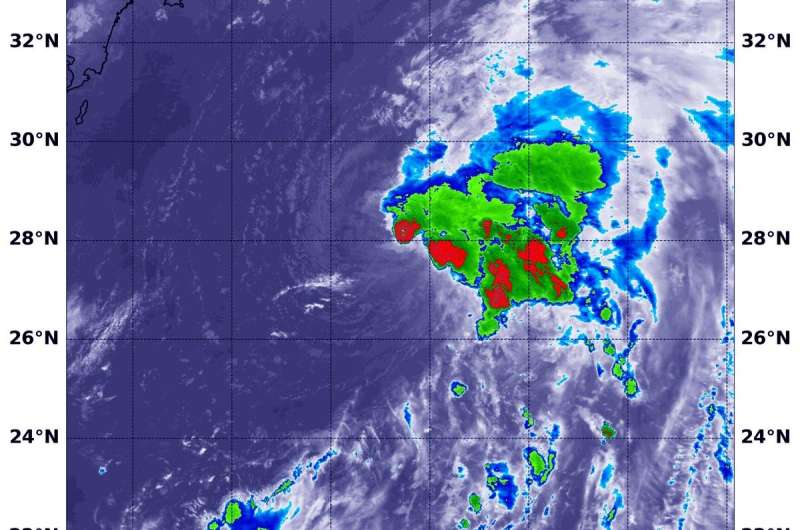On July 25, 2019 at 9:15 a.m. EDT (1315 UTC) the MODIS instrument that flies aboard NASA's Terra satellite showed strongest storms in Tropical Storm 07W were east of the elongated center where cloud top temperatures were as cold as minus 70 degrees Fahrenheit (in red) (minus 56.6 Celsius). Credit: NASA/NRL
Wind shear can push clouds and thunderstorms away from the center of a tropical cyclone and that's exactly what infrared imagery from NASA's Terra satellite shows is happening in newly formed Tropical Storm 07W.
NASA's Terra satellite used infrared light to analyze the strength of storms and found the bulk of them on the eastern side of the storm. Infrared data provides temperature information, and the strongest thunderstorms that reach high into the atmosphere have the coldest cloud top temperatures.
On July 25 at 9:15 a.m. EDT (1315 UTC), the Moderate Imaging Spectroradiometer or MODIS instrument that flies aboard Terra gathered infrared data on 07W and showed the strongest thunderstorms had cloud top temperatures as cold as minus 70 degrees Fahrenheit (minus 56.6 Celsius). Cloud top temperatures that cold indicate strong storms with the potential to generate heavy rainfall.
The storm is being affected my moderate vertical wind shear from the southwest. In general, wind shear is a measure of how the speed and direction of winds change with altitude. Tropical cyclones are like rotating cylinders of winds. Each level needs to be stacked on top each other vertically in order for the storm to maintain strength or intensify. Wind shear occurs when winds at different levels of the atmosphere push against the rotating cylinder of winds, weakening the rotation by pushing it apart at different levels. Wind shear can displace the clouds and showers of the system from around the center.
The Joint Typhoon Warning Center or JTWC noted at 11 a.m. EDT (1500 UTC) on July 25 that Tropical Storm 07W was located near 27.5 degrees north latitude and 137.4 east longitude, about 483 miles south-southwest of Yokosuka, Japan. 07W is moving to the north and has maximum sustained winds near 35 knots (40 mph/62 kph).
The JTWC forecast calls for 07W to move north. Once it reaches Japan, the system is expected to turn to the east-northeast and dissipate.
Provided by NASA's Goddard Space Flight Center
























